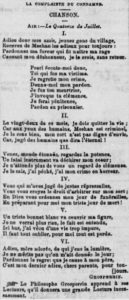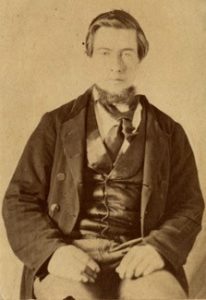MEEHAN, John (1841-1864)
Biography
John Meehan was born August 9, 1841, at Sainte-Catherine-de-Fossambault. He was the son of James Meehan, a farmer, and Catherine Mulcair, both Irish Catholics. After the death of James Meehan, the family sold their land and moved to Quebec City, where John Meehan became a carter.
The Meehan family did not get along well with another Fossambault family, the Pearls, even though they were related. On September 11, 1863, John Meehan met 16-year-old Patrick Pearl at Michael Lawlor‘s tavern on Saint-Vallier Street, in the Saint-Roch suburb. Pearl had come to town with his father to sell their produce. After exchanging words over a package Meehan wanted Pearl to deliver to Sainte-Catherine, Meehan and Pearl went out into the street. After further exchanges, they began to fight. Meehan was stronger than Pearl, and after knocking him down, began jumping up and down on his chest. At the same time, James Crotty, a carter who was an acquaintance of Meehan’s, hit Pearl on the head with his whip handle. Two women bystanders separated them and brought Pearl back into the tavern, but he collapsed and died shortly after. Meehan and Crotty fled the secne. Meehan was arrested the same day and imprisoned in the Quebec jail, accused of murder. Crotty was captured four days later.
Meehan went on trial before the Court of Queen’s Bench in February 1864, defended by noted Quebec City lawyer and politician John O’Farrell. After five days of testimony, much of it contradictory, the jury, composed of both anglophones and francophones, found Meehan guilty of murder. In this, they were following the directions of the trial judge, Charles Mondelet. After a series of objections by O’Farrell, Mondelet then sentenced Meehan to death. The jury had strongly recommended Meehan to the mercy of the court, thinking to avoid the death penalty, but legally, it was the only sentence Mondelet could impose. He set the execution for March 22.
There had been no civilian hangings in Quebec City since 1836. Several people had been sentenced to death, but all had had their sentences commuted after petitions to the governor. O’Farrell and others drew up petitions in favour of Meehan, asking that his death sentence be commuted to life in prison, since they felt that at worst he was only guilty of manslaughter. The petitions were signed by the mayor and city councillors, local members of parliament, many of the city’s lawyers, and thousands of residents of Quebec City and Fossambault. They were sent to the governor, Lord Monck. To the surprise of all, Monck refused to commute the sentence. Many blamed Monck himself, but he was following the recommendation of the Executive Council and in particular of the Attorney General, Antoine-Aimé Dorion, head of the Rouges. Although known to oppose the death penalty, Dorion declared that he saw no reason to commute Meehan’s death sentence. The petitioners continued their efforts, even meeting personally with the governor, but to no avail.
While awaiting the fateful day, Meehan was kept alone in a separate cell. Guards watched night and day to prevent him from committing suicide. Meehan was regularly visited by nuns and members of the Catholic clergy, and also by his mother. His co-accused, Crotty, who was still waiting for his own trial, also visited him a week before the execution.
On the morning of March 22, Meehan’s family paid him a last visit, in his cell. He was then brought into a small room immediately above the jail’s main entrance, which led directly onto the temporary scaffold erected over the entrance. A large crowd, between 5000 and 8000 people according to newspapers, gathered in the small space in front of the jail. Spectators climbed on trees and on the roofs of surrounding buildings. A fence hid the bottom of the scaffold, so that the public could see Meehan’s fall, but not his death struggles. Journalists looking out from the prison windows above the scaffold, however, could see everything, and reported it in macabre detail in their columns the next day. Meehan was brought out onto the scaffold, and addressed the crowd in English and then in French. As in most speeches by those condemned to die, at least as reported in newspapers, he warned the crowd against following his bad example. At the same time, he denied having intended to kill Patrick Pearl.
When the executioners opened the trap and Meehan fell, the crowd surged forwards to the fence, presumably to see the body, but were held back by the prison guards. Part of the crowd also wanted to rush to the governor’s residence, but this movement soon died down. Eager publishers quickly produced pamphlets describing the trial and execution. The well-known Quebec City street poet Grosperrin even circulated the “Complainte du condamné”, a song with mournful words but set to a tune from the French Revolution.
This was the last public hanging in Quebec City, and for a long time remained vividly imprinted on collective memory in the city. John Meehan was buried two days after his execution, in the Saint-Charles cemetery in Saint-Roch. At his trial a few months later, Crotty was found guilty of manslaughter only, and sent to the provincial penitentiary for 7 years.
– Donald Fyson, June 2015
Images
Bibliography
- Library and Archives Canada, RG4 C1, vol. 552, file 500 <http://heritage.canadiana.ca/view/oocihm.lac_reel_h2782/669>
- Bibliothèque et Archives nationales du Québec, «Le fichier des prisonniers des prisons de Québec au 19e siècle», <http://www.banq.qc.ca/archives/genealogie_histoire_familiale/ressources/bd/instr_prisons/prisonniers/index.html> (transcription of the Quebec common gaol registers, the originals of which are in Bibliothèque et Archives nationales du Québec, Centre de Québec, E17,S1)
- Exécution de John Meehan. Québec: Le Canadien, 1864. <https://archive.org/details/cihm_23191>
- Morning Chronicle, 8 to 13 February and 23 March, 1864.
- Procès de Meehan, accusé du meurtre de Pearl, condamné à être pendu le 22 mars prochain. Québec: L.P. Normand, 1864. <https://archive.org/details/cihm_94726>
Secondary sources
- Bizier, Hélène-Andrée. Crimes et châtiments: la petite histoire du crime au Québec, Volume I. Montréal: Libre Expression, 1982. p. 113-123.
- Fyson, Donald. “Prison Reform and Prison Society: The Quebec Gaol, 1812-1867”. In Louisa Blair, Patrick Donovan and Donald Fyson, From Iron Bars to Bookshelves: A History of the Morrin Centre (Montreal: Baraka Books, forthcoming).
- Lapointe, Vicky. «La dernière pendaison publique à Québec [1864]» (2015). <https://tolkien2008.wordpress.com/2015/03/20/la-derniere-pendaison-publique-a-quebec-1864/>

